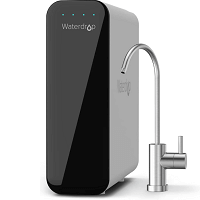Ultrafiltration is a method of water filtration much unlike reverse osmosis. Also referred to as UF, ultrafiltration utilizes the pressure of a standard home water system, in order to remove contaminants by forcing water through a semipermeable membrane. Through this method, ultrafiltration is capable of removing bacteria, parasites, and viruses, while also retaining minerals found in water. While it does bear a resemblance to reverse osmosis systems, ultrafiltration is considered to be a superior method of filtration, efficient at producing mineral rich, healthy drinking water.
What Exactly is Ultrafiltraion?
Through the use of hydrostatic pressure, ultrafiltration works similarly to reverse osmosis, forcing water through a semipermeable membrane. The overall success of this process is thanks to a membrane pore size of 103 to 106 Daltons, filtering away bacteria, viruses, endotoxins, and much more. This semipermeable membrane produces purified water with a very low density of silt, once the water is forced through. Fundamentally, the process of ultrafiltration doesn’t differ from RO, or even microfiltration, aside from the molecular size retained.
This semipermeable membrane is comprised of a thin layer of material capable of separating substances through pure force. The membrane process was once considered a dependable technology for desalination. With time, membrane processes became increasingly popular for bacteria removal, as well as other microorganisms, impacting odor, flavor, and color of resulting water. As membrane production advances continue to be made, as well as with module design, there is a noticeable decline in operating costs and capital.
How Does UF Work?
The membrane material found within ultrafiltration, utilizes hollow fibers which enables water to flow through both sides of the shell. Suspended solids of high molecular weight are retained alongside solutes, as the membrane allows water and low molecular weight solutes to pass through. Aside from the variations in retained molecular sizes, reverse osmosis and ultrafiltration aren’t different fundamentally, as well as nanofiltration and microfiltration. UF is ideal for the removal of a whole slew of contaminants that are larger than the pores of the utilized membrane, especially when combined with other forms of water purification.
As ultrafiltration systems utilize hollow fiber membranes, water is better enabled to flow through for better filtration. A large surface area is presented for particle adherence, while other membranes filter in from the outside. These fiber membranes feature a high resistance to chemicals, such as chlorine and oxidants. However, the TFC RO membrane, on the other hand is incapable of tolerating chlorine.
By comparison, a reverse osmosis system features an extensive form of filtration, due to the inherently small pore size of the RO membrane. An ultrafiltration system retains beneficial minerals that RO systems would otherwise remove. The downside to this type of filtration, is that a UF system will not remove fluoride, salts, or TDS from water sources. An RO system also requires a booster pump to operate properly, in order to increase water flow. UF systems operate on a low water pressure system, so booster pumps aren’t needed.
Microfiltration, Nanofiltration, and Ultrafiltration
The big difference between four various types of membrane based filtration lies with the reduced particle size, or membrane pore size. Determining which form of filtration is best suited to your needs, is all dependent upon your current water source situation, as well as the desired water quality. For each kind of membrane filtration, simply view the spectrum of reduction utilizing the chart below.
How is Ultrafiltration Used?
Each and every type of membrane based water filtration serves a different purpose to a variety of consumers. As such, most people who appreciate minerals being retained in their drinking water, makes UF the filtration method of choice. Plus, because it wastes less water, ultrafiltration systems may be used over an RO system. For example, in areas where water is more regulated, California residences may opt for RO over UF. Someone in the Carolinas, by comparison, where they struggle with fewer dissolved minerals, may opt for UF instead of RO. Ultrafiltration is sometimes utilized to recycle water after the process of filtration, for irrigation purposes. Microfiltration is capable of removing suspended solids ranging from sediment to algae. Nanofiltration is efficient at removing heavy solids in dairy, as well as softening purposes.
What is Ultrafiltration Capable of Removing?
A fine filter found within the UF membrane is capable of reducing particles up to 5,000 times smaller than a human hair, for a reduction of 90-100% of all contaminants. Ultrafiltration may not reduce specific organics, but it can perform better through the use of a carbon block prefilter. When installed with a prefilter, consumers will notice a marked improvement in the reduction of chlorine, lead, odor, cysts, and much more. Overall, you can also expect up to two years of life out of a UF membrane, before replacement is necessary.
Ultrafiltration systems have gained popularity over the stable water quality it produces, regardless of the water source. It also features a compact physical footprint, with capabilities of removing most viruses and organic molecules. UF does not require the use of chemicals either, except when cleaning membranes.
Characteristics of a UF Membrane
Regular maintenance is the top way to prevent fouling of a nanofiltration membrane, due to scaling, solids, and other microbiological agents, including algae, and microbes. Ultrafiltration is categorized somewhere between nanofiltration, and microfiltration. Thanks to a pore size ranging between 0.1 to 0.01 microns, ultrafiltration membranes prevent 90% of a macromolecular solute from passing through. Ultrafiltration systems are most applicable to situations including:
- Standalone systems
- Water softening
- Paper pulp mill effluent filtration
- Food and beverage industries
- Wastewater and industrial process water treatment and recycling
Benefits of Ultrafiltration
- Doesn’t generate wastewater
- Removes viruses and bacteria
- Quick and easy installation
- Operates at a lower pressure
- Retains essential minerals
Ultrafiltration systems are considered to be rather eco-friendly. With a 90-95% recovery rate, uf can be used to treat wastewater, and prepare it for reuse. A home ultrafiltration water system often benefits the environment as well, by reducing the amount of discarded plastic water bottles overall.
Filtration Development
Modern membrane technology didn’t technically get it’s start until the 1990s, with ultrafiltration getting it’s start during the 1960s. This was following the heals of the discovery of the 1950s discovery of the RO membrane. While it was first described toward the end of the 19th century, ultrafiltration has come a long way. It also came after MIT’s discovery in the beginning of the 60s, when they discovered polyelectrolyte complex hydrogels.
When polymeric membrane chemistry and processing techniques were getting their start through the manufacturing of filtration membrane. UF was made more efficient through the discovery of these new materials and manufacturing methods. Overall, this poised UF as a competitive process for efficient water treatment solutions. In fact, the global ultrafiltration membrane market grew to a size of $5.3 billion in 2019. Though recent events caused a little bit of a slump, the market is projecting a substantial recovery in 2021. Efficient advancements, as well as increasing water safety regulations, are expected to drive adoption upwards.

